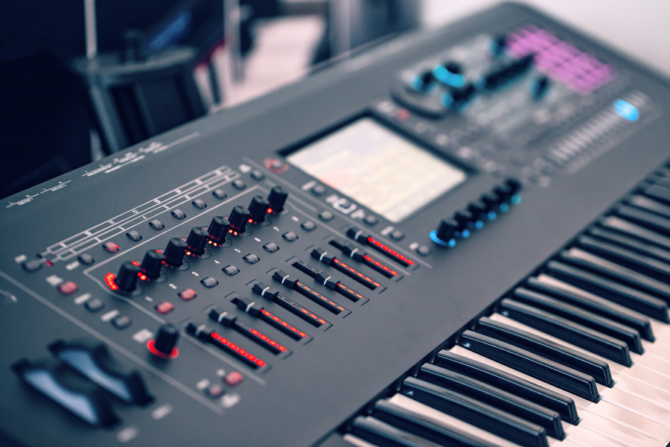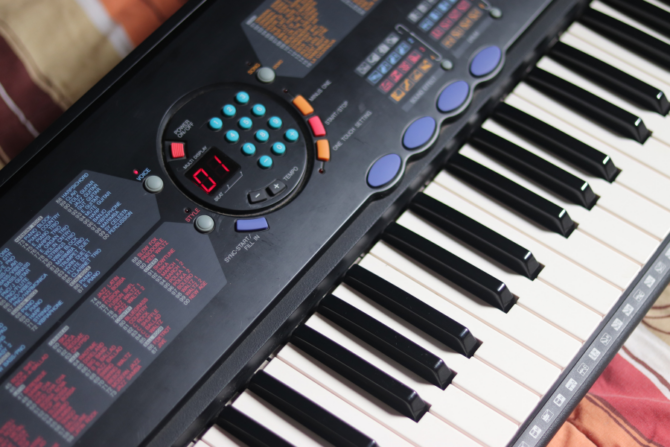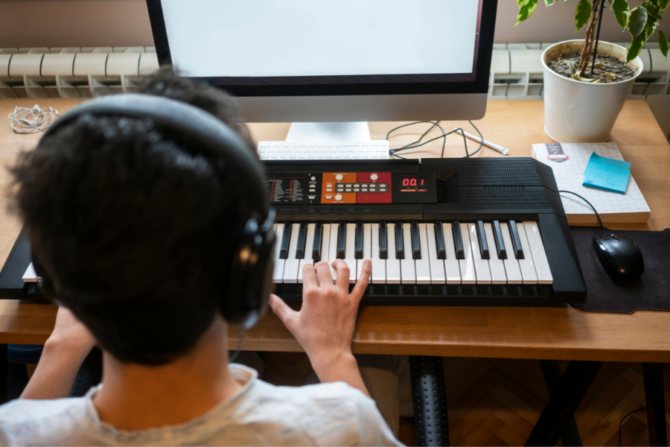Synthesizers and keyboards are often mistaken for one another, as they share many similarities in appearance and functionality. Both instruments utilize electronic components to generate sound, but they differ in the ways they create and manipulate those sounds. It is important to understand their distinctions to make informed decisions when choosing between the two instruments.
A synthesizer is a powerful tool made for musicians who want to create or adjust sounds in great detail. Often found as part of a keyboard, synthesizers come in various forms and complexities that enable artists to craft unique and experimental sounds. On the other hand, keyboards are designed for players seeking to perform with a broad range of pre-existing sounds, samples, and automated accompaniments. They cater to those who need versatility and ease of use.

Key Takeaways
- Synthesizers focus on creating and adjusting sounds, while keyboards offer a large variety of pre-existing sounds and accompaniments.
- Versatility and sound capabilities vary between synthesizers and keyboards, with the former catering to experimental musicians and the latter to a broader range of players.
- Factors like cost, learning and playing experience, and studio use should be considered when deciding between a synthesizer and a keyboard.
Table of Contents
- Key Takeaways
- Understanding Synthesizer and Keyboard
- Key Components of Synthesizers
- Crucial Features of Keyboards
- Types of Synthesizers
- Comparing Costs
- Versatility and Sound Capabilities
- Learning and Playing
- Considerations for Studio Use
- Advantages and Disadvantages
- Conclusion
- Video – Synthesizer vs Keyboard
- Frequently Asked Questions
Understanding Synthesizer and Keyboard
A synthesizer is an electronic instrument that uses various sound modules, such as oscillators and filters, to create and manipulate sounds. Synthesizers can generate a wide range of sonic textures and timbres by altering parameters like pitch, duration, and amplitude. They are used in various music genres, from electronic dance music to film scores.
A keyboard, on the other hand, refers to any instrument with a set of keys that can be played to produce sound. This includes acoustic pianos, organs, and electronic keyboards. Keyboards can have built-in synthesizers, meaning they can create and manipulate sounds like a standalone synthesizer. However, the term “keyboard” is typically associated more with the physical instrument and its key layout.
MIDI keyboards are a popular type of keyboard that connects to other music devices or software via a MIDI (Musical Instrument Digital Interface) connection. Unlike a traditional keyboard, a MIDI keyboard does not produce sound on its own; instead, it acts as a controller, transmitting data about the keys played to the connected device or software. This allows users to control virtual synthesizers and other sound-generating sources.
In summary, synthesizers focus primarily on sound generation and manipulation, while keyboards encompass a broader category of instruments that produce sound through their keys. Understanding the differences between as synthesizer and keyboard will help musicians select the appropriate tool for their specific needs, allowing them to create the desired sounds and musical styles.
Key Components of Synthesizers
Understanding Oscillators
Oscillators are the core sound generators in synthesizers. They create periodic waveforms, such as sine, square, and sawtooth waves to produce basic tones. Synthesizers typically have multiple oscillators, which can be mixed, tuned, and modulated to generate a wide variety of complex sounds.
Filters, Amplifiers and Envelopes
Filters play a crucial role in shaping the sound produced by oscillators. They can emphasize or attenuate specific frequencies, allowing for precise control over the synthesized sound. Common filter types include low-pass, high-pass, and band-pass filters.
Amplifiers, on the other hand, control the volume of the sound. They work in tandem with envelopes, which define the Attack, Decay, Sustain, and Release (ADSR) stages of a sound. The ADSR envelope determines how the sound starts, develops, and fades away, allowing for the creation of dynamic and expressive sounds.
Modulation and EQ Controls
Modulation is a technique used to enrich and add variety to synthesizer sounds. It involves the controlled modification of certain parameters, such as pitch, volume, or filter cutoff frequency, using modulation sources like LFOs (low-frequency oscillators), envelope generators, or external MIDI controllers.
EQ, or equalization, is the process of adjusting the balance between different frequency components of a sound. Synthesizers often have built-in EQ controls, which allow for the adjustment of specific frequency bands and the fine-tuning of the overall sound. This helps create a polished and refined tone, suitable for various styles and genres.
In summary, synthesizers are powerful musical instruments that rely on oscillators, filters, amplifiers, envelopes, modulation, and EQ controls to generate and shape a wide range of sounds. Each of these components plays a crucial role in the functionality and versatility of a synthesizer, allowing musicians to design and manipulate complex tones to suit their musical needs.
Crucial Features of Keyboards

Midi Data and Compatibility
Keyboards have the ability to send and receive MIDI data, which is a crucial feature for many musicians. This allows the keyboard to be connected to various devices like computers, sound modules, and other instrumental units for greater control and versatility. MIDI compatibility makes it easier for musicians to integrate the keyboard into their existing setup and expand its use with other MIDI-compatible gear.
Keyboard Styles and Types
There are various styles and types of keyboards available to cater to different needs and preferences. Some popular types include the stage pianos, which are designed for live performances, and portable keyboards like the Casio SA-76 and the Yamaha YPT 255. These portable keyboards are lightweight and compact, making them ideal for beginners and professionals alike who require a versatile instrument for practice, performance, or composing.
Weighted Keys, Sliders, and Buttons
One important aspect to consider when choosing a keyboard is the presence of weighted keys. Weighted keys are designed to mimic the feel of an acoustic piano, providing a responsive and realistic playing experience. Pianos like the Yamaha P255 and the Casio CDP-240 come with weighted keys that significantly enhance the overall playability of the instrument.
In addition to weighted keys, some keyboards also feature various sliders and buttons that provide easy access to sound adjustments and additional functionalities. These controls allow users to modify the instrument’s settings, sound characteristics, and more, without the need for additional MIDI controllers.
Overall, the crucial features of keyboards, including MIDI compatibility, diverse styles and types, and weighted keys with additional controls, contribute to their versatility and appeal to musicians at every level. The selection of the right keyboard depends on the individual’s requirements, preferences, and intended use of the instrument.
Types of Synthesizers
Analog Synthesizers
Analog synthesizers produce sounds using fluctuating electric voltage. The user can manipulate this voltage to change the tone or loudness of audio signals. Analog synths mainly use analog circuits to create this voltage, resulting in warmer and more organic sounds. These instruments have been popular since the 1960s and continue to be a favorite among musicians. However, analog synths can be more expensive and harder to maintain compared to their digital counterparts.

Digital Synthesizers
Digital synthesizers, on the other hand, use digital signal processing (DSP) to generate and manipulate sounds. These instruments can create a wide variety of sounds, including the emulation of traditional analog synths. Digital synths offer greater flexibility and affordability compared to analog models. Moreover, they tend to be more stable and easier to maintain. Some popular digital synthesizers are made by Moog and Nord.
Software and VST Synthesizers
Software synthesizers, also known as virtual instruments (VSTs), are applications that run on a computer and emulate the sounds of both analog and digital synthesizers. These software synths offer many benefits, such as lower cost, portability, and ease of use. VSTs are often compatible with digital audio workstations (DAWs), allowing for seamless integration into music production workflows. Spectrasonics and Arturia are two brands that make VST’s.
Imitator Synths and Creative Synths
Imitator synthesizers are designed to mimic the sounds of specific instruments, such as pianos, organs, and stringed instruments. These synths aim to provide the most realistic emulation of traditional instruments, often using advanced digital technology and sound modelling. Examples of imitator synths include:
- Emulative Synthesizers: Synthesizers that are designed to closely replicate the sounds of acoustic instruments such as pianos, strings, etc.
- Vintage Synth Emulations: Many modern synthesizers (hardware or software) are designed to emulate the sound and functionality of classic, vintage synthesizers.
- Sample-Based Synthesizers: Synthesizers that use recorded samples of real instruments as the sound source, which can be manipulated to closely mimic the original sounds.
Creative synths, in contrast, focus on generating unique and unconventional sounds. These instruments often feature unusual interfaces, innovative sound engines, or experimental sound design techniques. Creative synths enable musicians to explore new sonic possibilities and push the boundaries of electronic music. These include:
- Modular Synthesizers: These allow for a high degree of customization and experimentation, enabling the creation of unique, complex sounds.
- Wavetable Synthesizers: These offer a platform for designing intricate and evolving timbres by modulating and morphing between different waveforms.
- Granular Synthesizers: These create sounds by manipulating small fragments of sound, called grains, in various ways, allowing for experimental and often texturally rich soundscapes.
- Physical Modeling Synthesizers: These simulate the physical properties of acoustic instruments, enabling users to create realistic but also morphed or “impossible” instrument sounds by tweaking the model’s parameters.
- Hybrid Synthesizers: These combine various synthesis methods, offering a broad palette of sound design possibilities, and often include innovative features for creating new sounds.
Comparing Costs
When considering a synthesizer or a keyboard, the cost is an important factor to take into account. Synthesizers, being more advanced in terms of technology and features, tend to be more expensive than keyboards. However, the price range for both synthesizers and keyboards is quite broad, with options available for various budgets.
For keyboards, prices can start as low as under 100 dollars for beginner-friendly options and go up to several hundred dollars for high-end professional models. See our article Keyboards for beginners for a cost-effective starting point for those just beginning their musical journey. Moreover, if you are willing to spend a little more, you can find some of the best piano keyboards under 200 dollars that offer impressive features without breaking the bank.
In the case of synthesizers, the prices can range from a few hundred dollars for entry-level models to several thousand dollars for high-end, professional-grade synths. Higher-end synthesizers often boast extensive sound customization options, more advanced oscillators, and filtering, along with a greater range of modulation and effects capabilities. Although synthesizers may generally be more expensive than keyboards, the investment can be well worth it for those looking to explore a vast array of sounds and develop a unique musical style, especially in electronic music genres.
In conclusion, while both synthesizers and keyboards cater to different musical preferences and skill levels, it is important for the buyer to closely analyze their particular requirements and budget constraints when choosing between the two options. Ultimately, factors such as sound quality, available features, and overall usability should guide this decision-making process along with the cost.
Versatility and Sound Capabilities
Acoustic and Digital Piano Sounds
Acoustic pianos create music through the strings’ vibrations when hammers strike them, while digital pianos produce sounds using digital sampling. Digital sampling replicates acoustic piano sounds with varying degrees of accuracy. Digital pianos offer musicians the flexibility of playing in different sensitivity modes, emulating the playing experience of an acoustic piano.
Organ and String Sounds
Keyboards excel in reproducing organ and string sounds, often using digital sampling or physical modeling. Physical modeling simulates real-life musical instruments through mathematical equations and algorithms, mimicking the instruments’ characteristics. These methods enable musicians to access a vast library of organ and string sounds instantly.
Synth and Midi Sounds
Synthesizers outshine keyboards in terms of sound creation and manipulation abilities. Synths generate sounds using oscillators, filters, envelopes, and modulation sources, allowing for deep control over the original sound’s parameters. MIDI integration enables synthesizers to be used as sound generation devices for a wide range of digital audio workstations. The Yamaha Motif XS6 is an example of a synthesizer that excels in MIDI and sound creation capabilities.
Overall, the versatility and sound capabilities differ significantly between synthesizers and keyboards. While both produce a variety of musical sounds, synthesizers are ideal for sound creation and manipulation, while keyboards cater to a more general approach, focusing primarily on playback and performance.
Learning and Playing
Learning and playing a synthesizer and keyboard are unique experiences that cater to different musicians and professionals. Synthesizers are known for their wide range of sound capabilities, making them popular among producers and electronic musicians. On the other hand, keyboards tend to be more straightforward and easy to use, making them a common choice for beginners looking to learn the basics of piano playing.
When it comes to learning a new instrument, it’s essential to consider your individual goals and preferences. If you’re interested in creating unique sounds and experimenting with various soundscapes, a synthesizer might be the right choice for you. However, if your primary goal is to learn traditional piano techniques, a keyboard would likely be more suitable, as they often include built-in speakers, touch-sensitive keys, and multiple instrument voices.
For beginners wanting to learn how to play keyboards, it’s crucial to start with easy-to-follow lessons available in many formats, including online piano lessons and Yamaha Keyboard Apps. These lessons and apps can help even the most inexperienced musicians play their keyboards like a pro with minimal effort.
Additionally, keyboard technique plays a significant role in both synthesizer and keyboard playing. Since most synthesizer keyboards have unweighted keys and a very light touch, they require a different technique than playing a traditional piano keyboard. On the other hand, keyboard players benefit from practicing proper fingering and hand positioning while learning to navigate the instrument’s features.
In conclusion, choosing between a synthesizer and a keyboard depends on your musical goals and preferences. With both instruments offering unique benefits and challenges in learning and playing, musicians and professionals alike can find an instrument that aligns with their musical aspirations.
Considerations for Studio Use
When setting up a studio for music production, it is crucial to choose the appropriate equipment that fits your needs. In the context of choosing between a synthesizer and a keyboard, several factors come into play.
In a studio environment, the integration with a Digital Audio Workstation (DAW) is an essential aspect to consider. A synthesizer is known for its ability to produce a vast array of sounds, relying on audio signals to generate various tones and effects. This flexibility makes it a valuable asset for producers seeking to add unique textures and ambiance to their tracks. On the other hand, a keyboard is commonly perceived as a more traditional instrument with built-in speakers, perfect for those who need an all-in-one solution for playing and recording.

The compatibility with an audio interface also impacts the choice between a keyboard and a synthesizer. The audio interface serves as a way to connect the chosen instrument to a DAW. When looking for an audio interface, consider the number of inputs required for your studio setup, as this will vary depending on the number of synths or keyboards being used. Also, ensure that the interface supports the necessary connectivity options such as USB, MIDI, or analog outputs.
Another significant factor in the decision-making process is the availability of sound equipment for mixing and monitoring. High-quality headphones or studio monitor speakers are essential for accurate sound reproduction, allowing the producer to make precise decisions when it comes to mixing and mastering the track. Both keyboards and synthesizers can benefit from a solid monitoring setup to deliver the best possible audio quality.
Aside from the technical aspects, personal preferences and workflow also influence the decision between a synthesizer and a keyboard. Some musicians may feel more comfortable playing on a full-sized keyboard with touch-sensitive keys, while others might prefer the limitless sound design possibilities provided by a synthesizer.
To sum up, when choosing between a keyboard and a synthesizer for studio use, the decision should be based on factors such as integration with a DAW, audio interface compatibility, sound equipment availability, and personal preferences. By taking these aspects into account, producers can select the instrument that best fits their needs and creates a productive and enjoyable studio environment.
Advantages and Disadvantages
When comparing synthesizers and keyboards, it’s important to consider the advantages and disadvantages of each to make an informed decision.
Advantages of Synthesizers
Synthesizers offer a high degree of sound design flexibility, making them a versatile choice for musicians looking to create unique, rich tones. With oscillators, filters, and envelopes, synthesizers can produce a wide range of sounds by manipulating waveforms. This opens up the possibility to recreate natural, acoustic instruments or create entirely new sounds. Synthesizers are also often equipped with MIDI capabilities, allowing for better integration with digital audio workstations and other hardware controllers.
Disadvantages of Synthesizers
The versatility of synthesizers can come with a steeper learning curve compared to traditional keyboards. Beginners might find the interface of a synthesizer more challenging, as multiple parameters need to be adjusted to create specific sounds. Additionally, synthesizers may carry a higher price tag due to their sound-crafting capabilities.
Advantages of Keyboards
Keyboards are user-friendly and generally more accessible to beginners, making them a popular choice for those learning to play an instrument. With a variety of built-in preset sounds and accompaniments, keyboards enable users to quickly switch between different instruments and styles. This makes keyboards suitable for a wide range of musicians – from those playing recreationally to professionals. In addition, playing the piano offers numerous benefits for individuals of all ages, such as improved cognitive and motor skills, as outlined in this 17 science-backed benefits of playing the piano study.

Disadvantages of Keyboards
While keyboards are designed to offer a variety of sounds and accompaniments, their sound design capabilities can be limited compared to synthesizers. This makes them less suitable for musicians aiming to create their sounds or adjust existing samples in great detail. Furthermore, some low-end keyboards may lack the nuance and weighted feel of higher-quality digital or acoustic pianos, which could affect the expressiveness of a player’s touch.
When considering the differences between synthesizers and keyboards, note that individual preferences, skill levels, and musical goals will ultimately determine the most suitable choice.
Conclusion
Synthesizers and keyboards are both versatile and essential instruments in the music world. While they may look similar, they have distinct features and functions that set them apart.
A synthesizer, also known as a synth, is an electronic instrument that generates a wide range of sounds using audio signals. These sounds can mimic natural elements, human voices, electronic dance music elements, and various melodic textures. Synths offer greater flexibility for sound creation and manipulation, making them popular among producers and musicians who seek unique, customizable sound options.
In contrast, a keyboard refers to an instrument with a set of keys that produce sound when played. Keyboards can include pianos, organs, and electronic keyboards. Generally, a keyboard is more focused on the reproduction of traditional instrument sounds, like piano or organ, and may have built-in speakers for an all-in-one experience.
Both synthesizers and keyboards allow musicians to create and explore sounds, each with their unique capabilities. When considering the right instrument, it is essential to consider one’s musical objectives, preferences, and skills.
In summary, synthesizers provide a vast array of sound possibilities and offer an exciting level of control for users, whereas keyboards serve as more traditional instruments with a focus on familiar and well-known sounds. These final thoughts can provide guidance for musicians and enthusiasts when choosing between a synthesizer or a keyboard to best suit their musical needs.
Video – Synthesizer vs Keyboard
The musician, Ruby Biloskirka-Conley, demonstrates the different ways that she uses a keyboard compared to a synthesizer.
Frequently Asked Questions
A synthesizer, or synth, is an electronic keyboard that generates sounds using audio signals and can produce a wide range of sounds, including natural sounds, human sounds, EDM music, and melodies. On the other hand, a keyboard is mainly designed for sound generation and can also play many different styles with the use of automated accompaniments and samples.
Weighted keys offer a playing experience that closely resembles the feel of playing an acoustic piano. They have a heavier touch, which provides greater control over the dynamics and expression of the music. Players can use this to create a more nuanced and emotive performance compared to non-weighted keys, which tend to have a lighter touch.
Yes, many synthesizers can be used as MIDI controllers. This functionality allows the performer to control other devices, such as samplers and sound modules, using the synthesizer’s keyboard and other controls. By connecting the synth to a computer or hardware equipment via a MIDI interface, the musician can expand the range of sounds and capabilities available to them during a performance or recording session.
Yamaha synthesizers are known for their quality, versatility, and innovation. They offer a wide range of models to suit various skill levels and preferences, from beginner-friendly keyboards to professional-grade instruments. Yamaha synths often include an array of features and functions for sound generation, manipulation, and performance, making them a popular choice among discerning musicians seeking reliable and versatile instruments.
Electric organs are similar to keyboards in that they are both electronic instruments with a keyboard interface. However, they differ in their approach to sound generation and their intended use. Electric organs typically emulate the sound of a traditional pipe organ, often including drawbars and other controls for adjusting the timbre and tonality of the organ sounds. Keyboards, on the other hand, offer a much wider range of sounds and styles beyond the confines of organ music.
While both synthesizers and arranger keyboards are electronic instruments with keyboards, they differ in their focus and capabilities. Synthesizers primarily concentrate on sound creation and manipulation, allowing musicians to craft unique and complex sounds for their compositions. Arranger keyboards, however, focus on offering a range of pre-recorded backing tracks, styles, and accompaniments that the player can use to create full arrangements of songs. Arranger keyboards are particularly popular among solo performers and songwriters who want an all-in-one solution to help them compose and perform complex arrangements.

